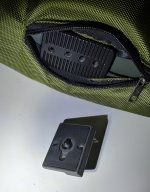Arca Swiss type Quick Release plates, basic inherent deficiencies
Hi -
....the standard Manfrotto QR plates.
This connection has always been unsatisfactory, because in regular use no matter how much I try to tighten it it inevitably becomes loose and starts to wobble while I try to rotate the scope.
Lately, the threads on my scope have become even more unreliable and a little stripped, and the scope has just fallen off a couple times (luckily so far, not catastrophically).
Is there any better plate I can use that will screw into multiple of those three screwholes to avoid these issues, or some other solution people use to get better connections?
Thanks!
The concept behind the Arca-Swiss type of QR plates, both
original or derivatives, only seems to be simple enough, to allow for
completely ignoring the most basic rules of engineering. Is it just lack
of better alternatives available, that most users still stick with this unlucky design? By
either just accepting it as such, or by using only marginal remedies as
loctite, instead of asking for better solutions.
1. Loosening of thread due to insufficient pretension.
In the industry's probably most frequent application of threaded bolts
withstanding periodic load variation: The fastening of cylinder heads
to engine blocks, its well accepted practice to use bolts as long as
possible in order to allow for sufficient elastic pretension in order to
permanently withstand bolt fatigue and thread loosening.
With Arca Swiss type plates this well proven principle gets completely
ignored. Even the anyway limited length of the screws possible, here gets
not properly used.
A considerable improvement applicable to most of Arca Swiss type plates
is to replace the existing screw by a set screw (without head).
This gets fully inserted to the bottom of the devices female thread. Only thereafter
the QR plate then gets fastened by a hex-nut pre-tensioning one (or several) (conical)
spring washer(s). By maximum length thread engagement tensioned only after insertion,
the devices female thread gets protected against deformation of the outer thread pitches and wear.
2. Rotation between adapter plate and device due to insufficient friction
2.1.The second deficiency often mentioned with Arca Swiss type plates is
rotation between plate and socket of the device, only partly also
related to bolt loosening. If this rotation should be prevented by
frictional momentum only, another rule, of physics,
applies: Frictional force = force perpendicular to surface x coefficient
of friction. As the area of surface doesn't appear in this formula, the resulting
perpendicular force gets only optimally used, if the frictional force is acting
at a diameter as large as possible (lever rule). Therefore the mating surface between
QR plate and device should be concentrated on a diameter as large as possible.
The surfaces near the center however should not touch.
2.2. Often the standard elastomer cover of QR plates is unsuitable. Too soft, so that
no sufficient pre-tension in the bolt can be established. And/or material without adequate
frictional properties. Good: Natural cork or even better: Thin synthetic (usually polyurethane)
drive belt material (as i.e. "Habasit").
If additional means to prevent rotation (as loctite or additional screws) are needed, its just
proof of the deficiency of the basic concept of the Arca Swiss design. Friction as only means
of rotational resistance may also serve beneficial as some overload protection. As an
anti-rotation screw has to be positioned so close to the main screw, damage in case of overload
is likely (lever rule again)
Quality of Arca Swiss type plates might usually be judged by difference in finish of machining or
surface treatment, but most seem to share the same unlucky design.
HW








